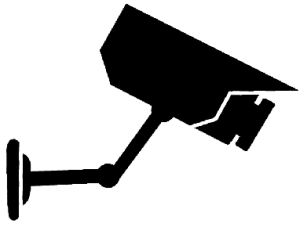
You see cameras everywhere. The doors are locked from the outside.
Why are schools increasing their security across the nation? According to the research firm IHS, the market size for security equipment in schools
is expected to surpass $720 million by this year.
Security company Tyco was hired to carry out a school-wide security update that has led to a greater amount of installed cameras and a key card as well as a camera entry
system.
The key card system is designed for teachers: they enter the building by swiping their ID through a sensor while students press a call button and are identified by staff members via camera before doors are unlocked.
Security specialist Steven Williams has been overseeing the installation.
“If it’s anything suspicious they won’t let you in,” Williams said.
According to Williams, most of the other schools in the surrounding jurisdictions have had this security for a few years already.
The school board approved the installation of interior cameras a few years ago, at which time then-principal Jay Pearson held a series of three meetings with the community, PTSA, and students. The third meeting took place last spring.
Williams also said that after those meetings, Pearson forwarded the outcome to cluster director Jim Kacur. At that point the process began for funding the install.
The source of funding for the equipment comes from proffer money and a portion of the money used for the school renovation.
William emphasized the fact that no money for the security install comes from the student budget.
“No money comes out of your books and handheld devices,” Williams said. “It’s not supposed to affect your day to day life.”
The camera installation is still in the process and is expected to be completed between November and December alongside the renovation.
“They can’t finish the camera installation in certain areas until the renovation is done,” Williams said.
School resource officer Tom Harrington believes that the cameras are advantageous.
“It’s just an asset to have them in the school,” Harrington said.
Harrington also highlighted an important role that they play in security.
Harrington said that they are a “deterrent for bad behavior.”
Throughout the school, students and teachers alike expressed support for the security increase, pointing out similar ways it can serve the community.
Freshman Kate Carnoil explained how she thought the cameras would limit bad behavior.
“You can’t do bad stuff and get away with it because the cameras are everywhere,” Carnoil said.
Also, according to IHS, video surveillance is expected to be the priority of school security spending in the future; IHS is predicting that that growth of video surveillance will be twice as fast as the growth of access control through 2017.
Junior Alek Langford also expressed confidence in the update and how it would help enforce school policies and keep students safe.
“I think it keeps unwanted visitors out of the campus and it prevents illegal activity from occurring about the school,” Langford said. “Security officials know.”
French teacher Matthew Hanlon believes that the update is beneficial all around.
“I think it’s not a bad idea to have what seems like passive security,” Hanlon said. “It’s there and it’s there for us to reference to if we need to.”
In addition to a general concern for safety, national tragedies like Sandy Hook have also triggered nationwide security increases in schools.
In an article from the Associated Press, executive director of the National School Safety Center Ronald Stephens said there have been about 500 school-associated violent deaths in the past 20 years.
“It started as far back as Columbine,” Williams said, “because they want schools to be safer.”
Schools are reacting to these tragedies; according to a 2013 survey by Campus Safety Magazine, 88 percent of participants from K-12 schools said they made or planned to make changes to their security programs as a result of Sandy Hook.
“You see that, and [the kids are] four, six, and eight years old. It plays on people’s minds,” Williams said. “Our priority is your [students’] safety and the staff’s safety. Period.”
